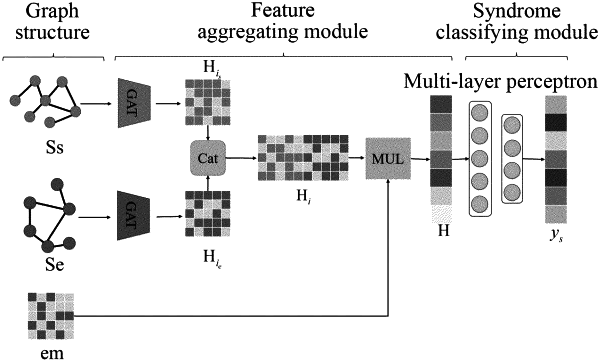| CPC G16H 50/70 (2018.01) [G16H 20/90 (2018.01)] | 7 Claims |

|
1. A traditional Chinese medicine (TCM) syndrome classification method based on multi-graph attention, comprising:
Step 1, acquiring a data set containing a plurality of clinical data, and constructing a symptom-symptom graph Ss, a symptom-syndrome element graph Se and a symptom embedding matrix em by using the relationship between a symptom and a syndrome element;
Step 2, performing graph attention feature aggregation on a symptom-symptom graph Ss and a symptom-syndrome element graph Se based on a multi-graph attention network to obtain a feature representation His between symptoms and symptoms and a feature representation Hie between symptoms and syndrome elements; performing matrix splicing on the feature representation His between symptoms and symptoms and the feature representation Hie between symptoms and syndrome elements to obtain a new symptom feature representation Hi; multiplying the symptom embedding matrix em with a new symptom feature representation Hi to obtain a symptom combination feature representation H, wherein the symptom combination feature representation H contains information of symptoms and syndrome elements; wherein the step of performing graph attention feature aggregation on a symptom-symptom graph Ss and a symptom-syndrome element graph Se based on a multi-graph attention network comprises:
1) Calculating an attention coefficient eij g of a node pair (i,j) in the symptom-symptom graph Ss and the symptom-syndrome element graph Se:
 where W∈RF*F′ is a shared weight matrix, F is the number of input features, F′ is the number of output features, Hi is the feature of node i, Hj is the feature of node j,
 a is the mapping of splicing vectors to real numbers, LeakyReLU is an activation function, and the node pair (i,j) refers to two points with edges connected in an undirected graph; a is the mapping of splicing vectors to real numbers, LeakyReLU is an activation function, and the node pair (i,j) refers to two points with edges connected in an undirected graph;normalizing the attention coefficient of each node pair (i,j) to obtain a normalized attention coefficient αij:
 where is a neighbor node of i;
2) Gathering the symptoms of the symptom-symptom graph Ss to a first-order neighboring point to obtain a first-order symptom aggregation representation His1′:
 where K indicates the number of heads of attention, Nis is a first-order neighbor of node is, αiSjS is a cross-correlation coefficient of attention of the symptom-symptom graph, Ws is a linear transformation matrix of input features of the symptom-symptom graph, Hjs0 is an original feature representation of adjacent nodes of the symptom-symptom graph, and σ is an ELU activation function;
adding a residual term to the first-order symptom aggregation representation His1′ to obtain the feature aggregation result His1 of a first-layer graph attention network of the symptom-symptom graph Ss as follows:
His1=His1′+Linear(His0) (4)
where Linear is a linear layer, His0 is a residual term of the symptom-symptom graph in the model;
similarly, the feature aggregation result Hie1 of the first-layer graph attention network of the symptom-syndrome element graph Se is as follows:
 where Nie is a first-order neighbor of the node ie, αieje is a cross-correlation coefficient of the attention of the symptom-syndrome element graph, We is a linear transformation matrix of the input features of the symptom-syndrome element graph, Hje0 is an original feature representation of the adjacent nodes of the symptom-syndrome element graph, and Hie0 is a residual term of the symptom-syndrome element graph in the model;
3) By stacking multi-layer graph attention, aggregating the features of high-order adjacent nodes of the symptom-symptom graph Ss and the symptom-syndrome element graph Se, respectively, to obtain the feature aggregation result Hisl of the attention network of the lth-layer graph of the symptom-symptom graph Ss as follows:
 where l is the current number of layers, and L is the total number of layers in the graph attention network, in which 1<l<L;
the feature aggregation result Hiel of the lth-layer graph attention network of the symptom-syndrome element graph Se is as follows:
 4) if the multi-head attention in the last layer takes the average of all multi-head attentions, obtaining the feature aggregation result HisL of the Lth-layer graph attention network of the symptom-symptom graph Ss as follows:
 the feature aggregation result HieL of the Lth-layer graph attention network of the symptom-syndrome element graph Se is as follows:
 the feature aggregation result HisL of the Lth-layer graph attention network of the symptom-symptom graph Ss is the feature representation His between symptoms and symptoms, and the feature aggregation result HieL of the Lth-layer graph attention network of the symptom-syndrome element graph Se is the feature representation Hie between symptoms and symptom elements;
Step 3, based on the symptom combination feature representation H, determining a category of syndrome ys according to a formula:
ys=sigmoid(W2(W1*H+b1)+b2) (12)
where W1 and W2 are the weight matrix of the first layer and the second layer, respectively, b1 and b2 are the offset vectors of the first layer and the second layer, respectively, and the category with the highest probability is the result of classification.
|